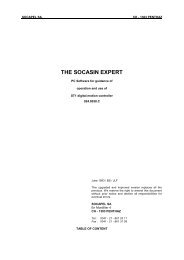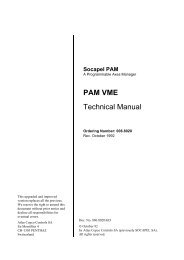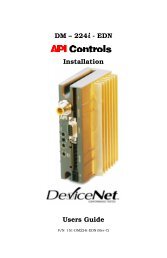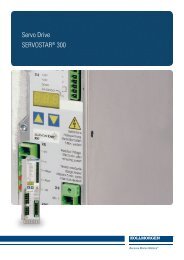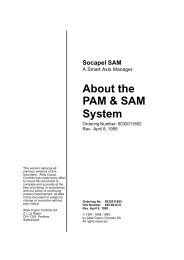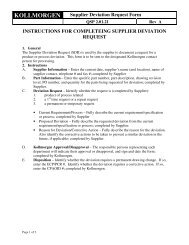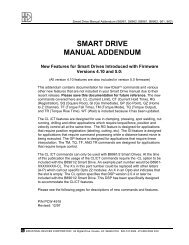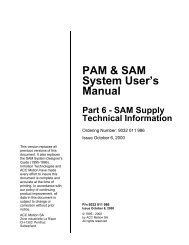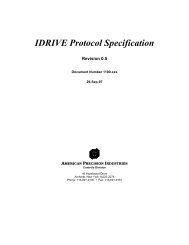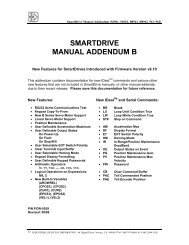Software for the synchronization of axes - Kollmorgen
Software for the synchronization of axes - Kollmorgen
Software for the synchronization of axes - Kollmorgen
Create successful ePaper yourself
Turn your PDF publications into a flip-book with our unique Google optimized e-Paper software.
SOCAPEL SA SOFTWARE FOR SYNCHRONIZATION OF AXES 024.8068.A8.8 PERIODICITY8.8.1 Periodic ModeMotor-driven <strong>axes</strong> can be classified as belonging in one <strong>of</strong> two categories- <strong>axes</strong> having a limited degree <strong>of</strong> travel : <strong>for</strong> example, a machine-tool bed;- <strong>axes</strong> having an unlimited degree <strong>of</strong> travel, in most cases operating in a singledirection : <strong>for</strong> example, printing-press cylinder; conveyor belt; cutting-tool headetc.The latter types <strong>of</strong> <strong>axes</strong> include <strong>the</strong> notion <strong>of</strong> "periodicity" : motor revolution, cylinderrevolution, space between cars, chain links etc. With <strong>the</strong>se <strong>axes</strong>, <strong>the</strong>re is no point insynchronizing <strong>the</strong> slave shaft with <strong>the</strong> original position <strong>of</strong> <strong>the</strong> master shaft : <strong>the</strong> position<strong>of</strong> <strong>the</strong> latter might be far-distant if <strong>the</strong> slave has been operating out <strong>of</strong> synch <strong>for</strong> a longperiod. Hence synchronizing is per<strong>for</strong>med using <strong>the</strong> nearest period.The earlier discussion concerning relative positioning <strong>of</strong> <strong>the</strong> master and slave shaftsintroduced <strong>the</strong> variable PMUS <strong>for</strong> <strong>the</strong> master and <strong>the</strong> variable INTV <strong>for</strong> <strong>the</strong> slave. Thenotion <strong>of</strong> periodicity can now be introduced, in <strong>the</strong> <strong>for</strong>m <strong>of</strong> two new variables, MOMUSand MOPHI. MOMUS contains an integer value that is <strong>the</strong> closest expression <strong>of</strong> <strong>the</strong>number <strong>of</strong> counted periods contained in PMUS.PMUSPeriodicityMOMUSPositionFigure 8.11More precisely, MOMUS follows PMUS at a distance <strong>of</strong> one period at <strong>the</strong> most. Asimilar arrangement exists between MOPHI and INTV. Thus when synchronizing isrequired, <strong>the</strong> difference taken into account is not that between INTV and PMUS, butra<strong>the</strong>r that between (INTV-MOPHI) and (PMUS-MOMUS).This notion <strong>of</strong> periodicity can be applied at <strong>the</strong> master or <strong>the</strong> slave, or both. Themaster and slave periods can be equal or different : <strong>the</strong> choice is made in <strong>the</strong>"periodicity" parameter groups.When <strong>the</strong> system increments MOMUS by one period, bit 2 <strong>of</strong> STATC is set to "1". Thisbit can be used by <strong>the</strong> sequencer to trigger a sequence.75





